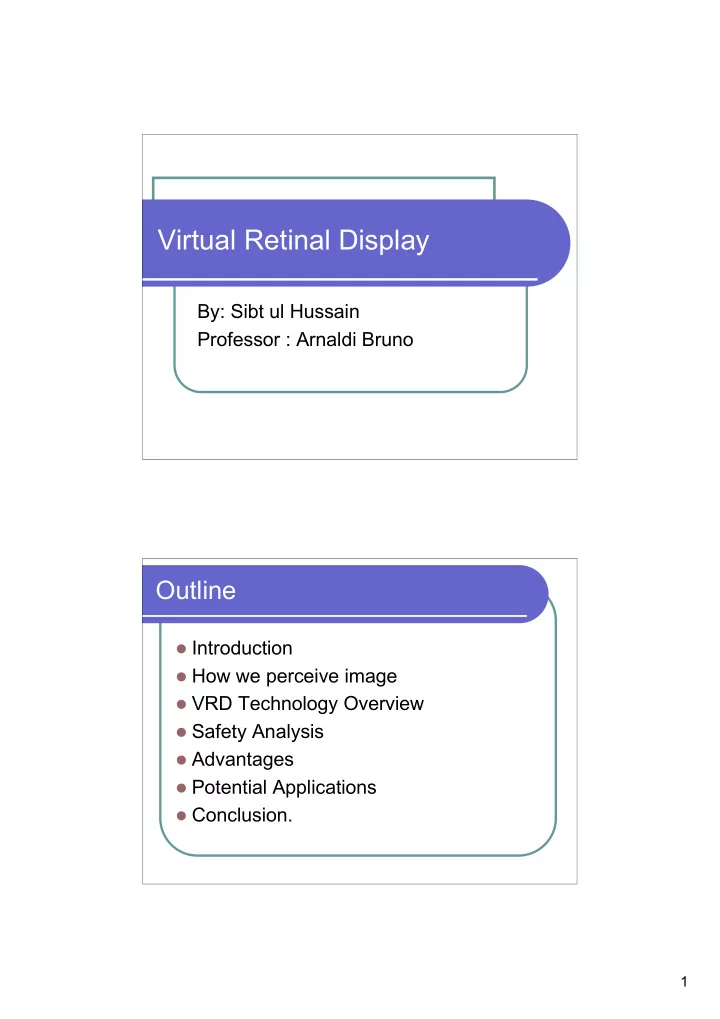

Virtual Retinal Display By: Sibt ul Hussain Professor : Arnaldi Bruno Outline Introduction How we perceive image VRD Technology Overview Safety Analysis Advantages Potential Applications Conclusion. 1
Introduction Virtual Retinal Display is a display technology which scans modulated laser light on the retina of viewer’s eye to create an image. The viewer’s perception & Virtual How we perceive images Macula Retina Photoreceptors Rods: 125 x 10 6 Cones: 6 x 10 6 Macula Fovea Fovea 2
Virtual Retinal Display: Technology Overview System Description Video Source Control and Drive Electronics Light Source Scanner Assembly Pupil Expander Viewing Optics VRD with Eye Tracking Virtual Retinal Display: Technology Overview Modulate Light Signals Red Diode Multiplexing according to pixel Laser Circuitry Intensity Blue Argon A-O Laser Modulators Optical Fiber Green Helium A-O Laser Modulators Scanner Assembly Control Signals Control and Drive Electronics Viewing Optics Synchronization VGA Video Signals Source Eye 3
System Description Control and Drive Electronics: Processing of input video signal. Generation of control Signals for the acoust- optical modulators. Synchronization of the vertical and horizontal scanner. Overall system timing. System Description (Light Source) Type Wavelength[ Optical nm] Power[mW] Red light Diode laser 650 3.0 source Green Helium-Neon 543.5 1.5 light source Blue light Argon laser 488 14.5 source 4
System Description :Raster Scanning CRT Flyback Boustrophedonic Scan System Description:Scanner Assembly Horizontal Scanner Mechanical Resonant Scanner (MRS) : Operating frequency = 15.75 KHz ~18.9 KHz Contain neither moving magnet or moving coil. Torsional spring and mirror configuration with mirror (3mm X 6mm). MEMS (Micro Electromechanical System) Vertical Scanner Galvanometer with a second mirror (60 Hz). Constraints: Resolution, field of view or image size 5
System Description:Scanner Assembly System Description: Perception CRT Methodology : Phosphorous persistence VRD Methodology: How ? Visual Cortex 6
System Description Viewing Optics Exit pupils Photodetector. Contain special assembly for occluded or augmented vision System Description: Viewing Optics 7
The VRD With Eye Tracking A map of landmarks (fovea, optic nerve) of retina is generated. Unmodulated Light reflected from the retina is monitored. Changing content of reflected light is sampled at the sampling rate. Scanner position at the time of each sample is used to correlate the position of sample. Sample position and the content represent a map. The VRD With Eye Tracking Relative position of landmarks is used to track the viewing direction of eye. Relative position of generated map or pattern will vary according to the viewing direction. By identifying the pattern and correlating relative orientation of pattern to referenced pattern orientation, viewing direction is determined at the current instant 8
Safety Analysis Maximum Permissible Exposure (MPE) The level of exposure or irradiance which can be thought of as the theoretical border between safe and potentially harmful. The output power of VRD is in the range of [100-300] nano watt. Worst case analysis is performed to check the safety bounds. ANSI Z136.1 (8 hour continuous exposure, sweep time for each pixel= 40 nano sec, frequency=60 Hz) Safety Analysis 9
Comparison of Energy levels Advantages Color range: High saturated pure colors Luminance and Viewing Modes (60nW ~ 300nW) See through mode (Augmented mode) Occluded mode. Contrast Ratio: Power Consumption: Cost: 10
Applications: Head Mounted Displays Common Characteristics: NOMAD Applications: Head Mounted Displays NOMAD Commercial purposes: Defense purposes 11
Applications: Head Mounted Displays Commercial Purposes: Applications: Head Mounted Displays Defense Purpose: 12
Applications : Low Vision Aid Get Input From Apply machine Vision Input to VRD with Camera Algos to detect Obstacles Enhanced Information Applications: Low vision Aid 13
Applications: Interactive VRD Pilot’s Dilemma : Spent about 50% time while looking down on the navigational scales to identify their locations which causes serious hazards. Applications : Automotive Industry : Superimposed maps on driver’s view Medical: To aid image guided surgery. Consumer Products: 14
Conclusion Sufficient amount of work still left Color displays Size Resolution limitations Stereo displays. Detailed safety analysis Current research issue MEMS based one scanner for both horizontal and vertical scanning. Questions: ? 15
References [1] Homer Pryor, Thomas A.Funress III and Erik Viirre,The virtual Retinal Display : A New Display Technology Using Scanned Laser Light, In Proceedings of Human Factors and Ergonomics Society, 42nd Annual Meeting,1570-1574,1998. [2] Richard S.Johnston, Stephen R.Willey, Development of a Commercial Virtual Retinal Display, Proceedings of Helmet- and Head-Mounted Displays and Symbology Design,2-13,1995. [3] Lin, S-K. V., Seibel, E.J. and Furness, T.A.III, Virtual Retinal Display as a Wearable Low Vision Aid, International Journal of Human-Computer Interaction,15(2),245-263,2003. [4] Tidwell.M,A Virtual Retinal Display for Augmenting Ambient Visual Environments, Master's Thesis University of Washington,1995. [5] Erik Viiree,Richard Johnston, Homer Pryor et.al,Laser Safety Analysis of a Retinal Scanning Display System , Journal of Laser Applications,9,253-260,1997. [6] Virtual Retinal Display (VRD)Technology, Web Page [7] Head-up Display, http ://www.microvision.com/hud.html [8] US patent EP1053499, Virtual retinal display with eye tracking 16
Recommend
More recommend